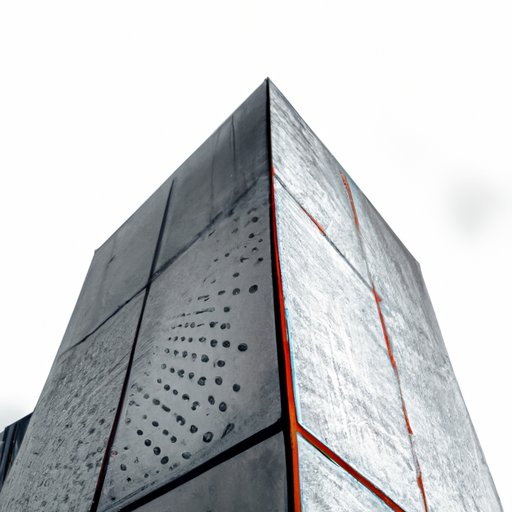Introduction
Have you ever noticed how often cubes appear around us? From dice to game boards, from buildings to household objects, cubes are everywhere. Understanding what cubes are and their fundamental properties is essential in many fields, such as architecture, engineering, and art. This article aims to provide a comprehensive guide to the cube, including its definition, characteristics, geometric properties, practical applications, and artistic significance.
All You Need to Know About Cubes: From Definition to Practical Applications
Cubes are a three-dimensional geometric shape that is made up of six identical square faces. They are also known as hexahedrons since they have six faces, and their faces are all flat polygons. Cubes are regular polyhedra, meaning that all their sides are of equal sizes, and each corner of a cube is at the same distance from the center.
The most common examples of cubes are dice used in board games, Rubik’s cubes, and boxes. Cubes are also present in nature, for instance, salt crystals are cube-shaped, and some minerals have cube-shaped crystals.
Understanding the Geometry of a Cube: A Comprehensive Guide
A cube has several defining features which include six faces, twelve edges and eight vertices. The faces of the cube are perpendicular to each other and connected by twelve edges. The corners of the cube where the edges meet are called vertices.
The relationship between the faces, edges, and vertices is also important to understand. Each corner of the cube has three edges and three faces connected to it. Every edge of the cube has two faces and two vertices connected to it. Each face of the cube has four edges and four vertices connected to it.
Calculating the angles in a cube is also essential. Since each face of a cube is a square, all four angles are 90 degrees. The cube has six faces, so it has 24 angles total. Every vertex in the cube has three angles of 90 degrees each, which means a cube has eight vertices and a total of 24 right angles.
How to Draw a Perfect Cube: A Step-by-Step Tutorial
The simplest way to draw a cube is to draw a square and then add depth to make it three-dimensional.
The materials you will need to draw a cube include a pencil, a ruler, and a blank sheet of paper. Here is a step-by-step tutorial:
- Draw a square in the center of the paper.
- Extend the sides of the square by drawing horizontal lines to the left and right of the square.
- Draw vertical lines at the top and bottom of the square to complete the sides of the cube.
- Erase the lines inside the square that are no longer needed.
- Shade the cube to give it a three-dimensional feel.
To make the cube look more realistic, you can add highlights and shadows to the surface, which will give it depth and dimension.
The Beauty Behind the Cube: Examining Cube-Based Art and Architecture
Cube-based designs are ubiquitous in architecture and art. Cubes are appreciated for their symmetrical and clean appearance, and their simplicity often represents modernism.
The use of cubes in architecture is evident in many buildings, such as the Seagram Building in New York City. Architects often use cubes to create functional spaces while giving the building a sense of balance and unity.
Cubes are also present in various artworks, like the sculptures of Alexander Calder that utilize geometric forms to create abstract compositions. Piet Mondrian’s painting “Composition II in Red, Blue, and Yellow” features cubes arranged in a grid-like pattern that creates a sense of order and harmony.
Cube vs. Other Shapes: What Makes a Cube Unique?
Compared to other shapes such as spheres, pyramids, and cones, the cube’s most unique property is its symmetry. Since a cube has six faces, each of which is a square, it has a high degree of symmetry and is recognizable from many angles.
The uniformity of the cube makes it useful in practical applications, such as in packaging, where it is easy to stack and store. Cubes are also prevalent in engineering, where they are used to provide support and stability for structures and machines. In architecture, cubes provide a sense of order and balance, organizing spaces in a functional and beautiful way.
The Mathematical Properties of a Cube: Exploring its Volume, Surface Area, and More
Cubes have well-defined mathematical properties that are important in numerous fields.
The volume formula for a cube is given as s^3, where s represents the length of one side of the cube. The surface area formula is 6s^2, since a cube has six faces that are all squares.
The cube is unique because of its symmetrical shape, which allows straightforward computational and planning capacities in architecture, engineering, and construction. Other mathematical properties of the cube include the length of the diagonals and the angles between the edges. The length of the straight line that runs through opposite corners of the cube is known as its diagonal, which can be calculated by multiplying the length of one side by the square root of three.
Conclusion
Cubes are integral in our everyday lives from household items to modern architecture. Understanding their definition, geometry and practical applications can offer new solutions for everyday problems. We have seen how the cube’s unique symmetry offers a range of benefits across many industries and how artistic appreciation of this form can create order and simplicity in our daily lives. Cubes may appear simple, but they are commonly applied in a vast array of fields, and comprehension of this form is essential for continued innovation.
